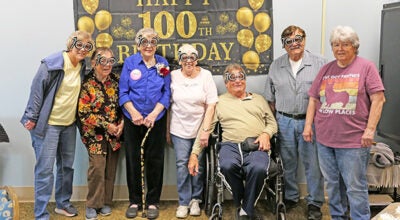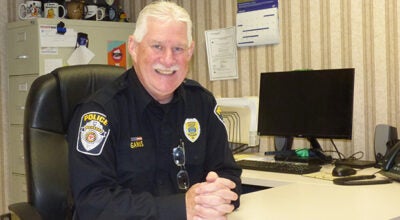Boulder rededication serves as reminder of changing interpretations of history
Published 4:43 pm Saturday, July 6, 2013

Niles Students from New Tech held a short parade illustrating how the boulder arrived at Fort St. Joseph (Leader photo/KIMBERLY WYNN)
The rededication of the boulder at Fort St. Joseph took place in the grassy alcove which has been reserved for this marker of history for more than 100 years.
Surrounded by a woodsy terrain, about 100 people gathered at 2 p.m. Saturday to recognize the significance of the fort and the boulder that marks its presence as a place where people of many nationalities gathered together in war and peace to help found another piece of the growing nation known as the United States.
“It turned into a bigger project than intended,” Jack Strayer, the master of ceremonies for the rededication, said of the grass roots effort which started with the women of Niles who collected money to move the boulder from a farm field to its present site.

Richard Weigel, superintendent of Niles Community Schools, portrayed Judge Orville Coolidge, giving his speech at the boulder dedication 100 years ago. (Leader photo/KIMBERLY WYNN)
That effort encompassed school children’s pennies, an art exhibit, magazine sales and a performance and culminated in a parade, according to Barbara Wood Cook, the chair of the Fort St. Joseph Archaelogical Advisory Council.
One of the highlights of the rededication ceremony was Richard Weigel, the superintendent of Niles Community Schools, who portrayed the part of Judge Orville Coolidge, giving his speech at the original dedication of the boulder.
But it was Michael Nassaney, a professor of anthropology at Western Michigan University, who brought the real meaning of the ceremony to light.
“History is important to us,” Nassaney said. “It provides a connection to the past. Its meaning to us is constantly changing. Our historical understanding of this place is very different from 100 years ago.”
Nassaney pointed to the “control” the French had over the spot and how they were viewed as the conquerors over a savage area.
“It was meant as a symbolic place,” Nassaney said of today’s changed viewpoint of the fort and its people. “It was a massive area (the French) claimed but did not control.”
Thus, the place’s history is a coming together of many people — from Native Americans to Spanish to British to French and the subsequent melding of many into the single nation that stand today.
Nassaney continues to spearhead efforts at uncovering artifacts of the site, which was discovered partially covered by a dump and partially by the St. Joseph River.
“We got lucky,” he said of his discovery 15 years ago and pointing to the fact that only 5 percent to 10 percent of the fort has been uncovered.
“This project will go into the future for many years,” he said.






